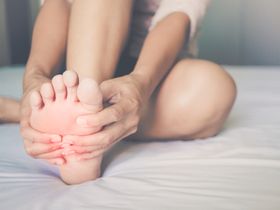Understanding Which Exercises Can Help Relieve Heel Bursitis
Learn more about exercises that can relieve heel bursitis, alongside the symptoms, tips, and home remedies you can use.
Published June 29, 2022
Heel bursitis is a common, global condition that people suffer from. This condition is characterized by inflammation in the bursa; usually, flare-ups occur towards the back of the ankle. The bursa becomes inflamed usually due to over-use or strain placed on the tissues around the area, as it crucially prevents the Achilles Tendon from rubbing on the calcaneus bone during movement of the ankle. The main complaint that people suffering from heel bursitis complain about the most is the pain at the back of the heel.
Without exercise adaptation, alongside strengthening and stretching exercises, heel bursitis usually will not go away on its own. Continuing to exercise with ankle movements will likely cause more inflammation and pain.
Exercises for Heel Bursitis Relief
It is advised to rest the inflamed ankle after a flare-up of pain associated with heel bursitis. Thereafter, it is important to gradually resume exercise to not aggravate the bursa. In managing your condition, it is also recommended that you do heel pain exercises daily.
Ankle pumps are an effective mobility exercise to maintain the range of motion in the ankle joint. The chances of aggravating your pain or causing a flare are extremely low. You can do this exercise by sitting with the legs together out of strain with your heels on a soft surface. Point the toes downwards, feeling the movement in the ankle joint. Then pull the toes up towards you by engaging the front leg muscles.
Stretching the Achilles Tendon and calf muscles is a great exercise for reducing symptoms associated with heel bursitis. Lengthening the muscles which are putting tension on the bursa should improve your symptoms.
Stretching can be done with the forefoot placed up against the wall, with the heel supported on a soft surface on the floor. Lean into the wall, which you should then feel in the calf muscle or behind the leg. You can also make use of a step to apply the stretch to the calf muscle. This can be done by placing the forefoot on the edge of a step and slowly lowering the heel down with a straight leg, applying the stretch to the muscle.
Exercises to Avoid With Heel Bursitis
It is important to avoid doing vigorous exercises immediately after a period of rest. For example, running uphill will strain the heel even more, and this will increases injury risk. Thus, this kind of exercise should be avoided. Consult our blog for more info on how you can avoid heel pain when running. Ice can be applied several times to the painful area throughout the day, for 15-20 minutes. This will help reduce the inflammation and pain you may be experiencing. Orthotics have also been well documented to aid in reducing symptoms of heel bursitis.
Related Articles

What Causes Middle Foot Pain and How to Get Rid of It
Upstep Staff
January 26, 2024

Super Shoes: What Are They and How Do They Work?
Upstep Staff
September 19, 2024

4 Best Insoles for Tennis Players to Prevent Plantar Fasciitis
Janik Sundstrom
November 11, 2025

5 Best Foot Supination Exercises: Enhance Stability
Upstep Staff
August 19, 2025

Fitness Walking & Hiking Custom Orthotics—2026 Review
Janik Sundstrom
December 9, 2024
Related Posts
Babafemi Adebajo
Heel Bursitis Home Treatment Guide
Janik Sundstrom
Custom Orthotics for Heel Pain—2026 Review
Babafemi Adebajo
What Is Acupressure and How Can It Relieve Heel Pain?
Janik Sundstrom
4 Tips for Relieving Heel Pain During Pregnancy
Janik Sundstrom
Benefits of Yoga for Heel Pain
Babafemi Adebajo
How to Relieve Foot Pain From Cycling
Staff Writer



